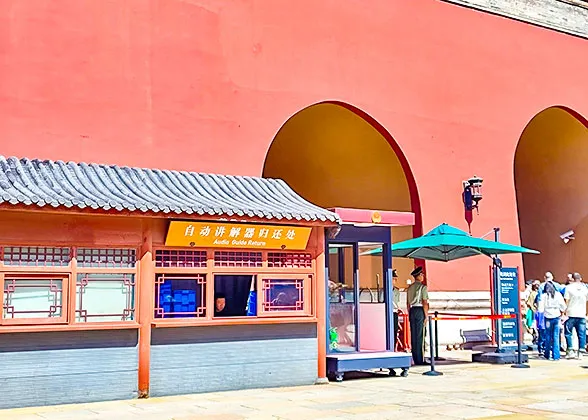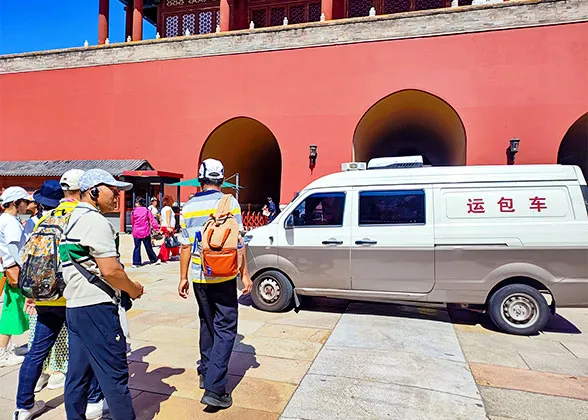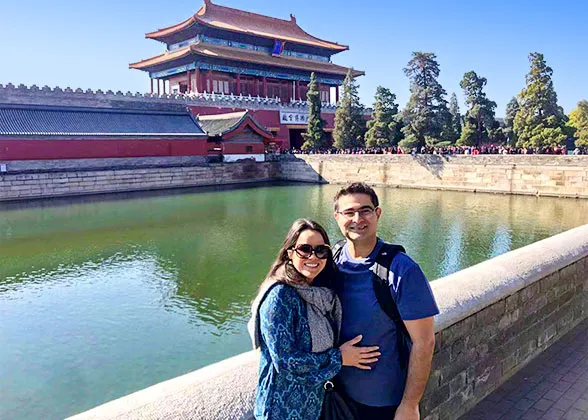Gate of Divine Prowess (Shenwumen)
The Gate of Divine Prowess, located at the center of the northern side of the Forbidden City, features a two-story structure. The ground floor presents a flat rectangular shape, supported by a marble base, with three arched gateways in the middle, and an inscribed plaque above reading "The Palace Museum".
The second floor, built on a marble pedestal, includes a tower surrounded by a veranda and marble balustrades. The plaque "Gate of Divine Prowess" hangs from the eaves, adorned with blue-background gold-plated copper characters. The roof is covered with yellow glazed tiles, and the interior ceiling features a lotus and aquatic grass pattern.
The second floor, built on a marble pedestal, includes a tower surrounded by a veranda and marble balustrades. The plaque "Gate of Divine Prowess" hangs from the eaves, adorned with blue-background gold-plated copper characters. The roof is covered with yellow glazed tiles, and the interior ceiling features a lotus and aquatic grass pattern.
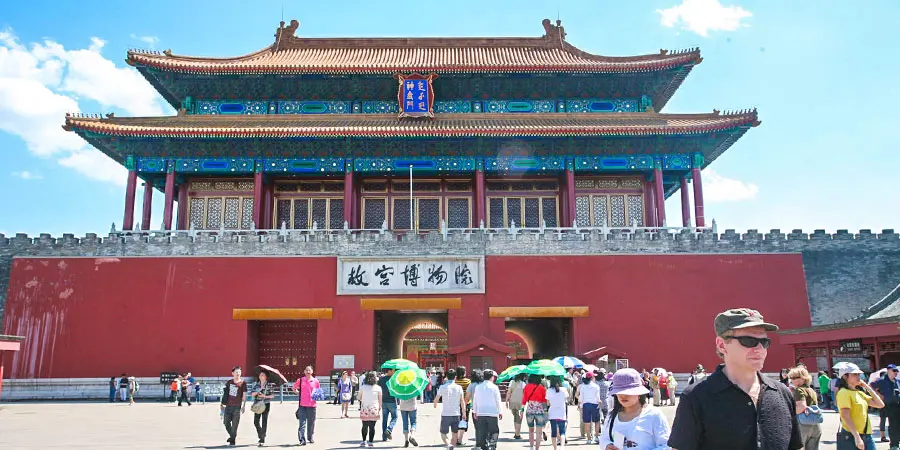 |
| Gate of Divine Prowess |
What was the Gate of Divine Prowess Used for?
Constructed in 1420, it was originally named Xuanwu Gate, after the Black Tortoise, a mythical creature symbolizing the north in ancient Chinese cosmology. Later, it was renamed Gate of Divine Prowess. The plaque "The Palace Museum" has been displayed since 1971. From 1420 to 1911, the gate served several key functions:
Entry and Exit for People Below the Emperor's Rank
The Gate of Divine Prowess was the primary gate for concubines, officials, guards, eunuchs, maids, and craftsmen entering or leaving the Forbidden City. The emperor, being of supreme status, typically used the grand Meridian Gate instead. Notably, Puyi (1906-1967), the last emperor, exited through this gate when he was expelled from the Forbidden City in 1924.
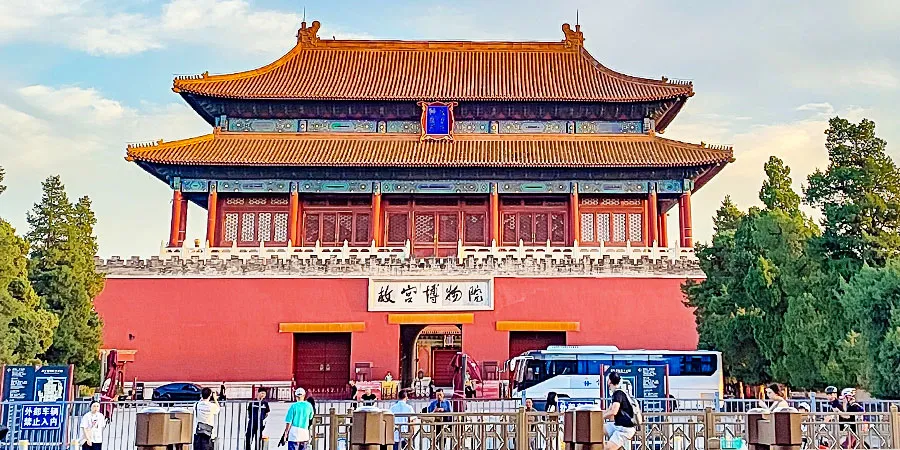 |
| Divine Prowess Gate Sunset |
Waiting Area for Imperial Consort Selection
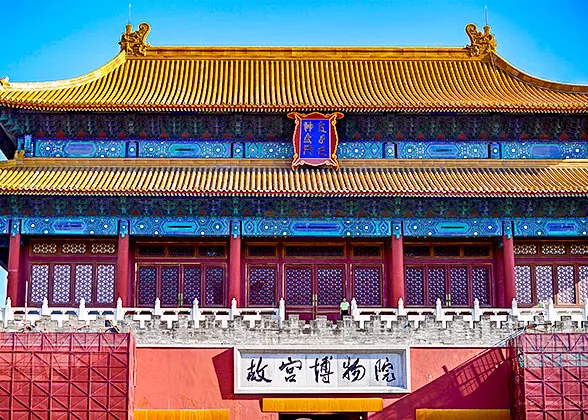 |
| Gate of Divine Prowess |
During the Qing Dynasty (1644-1911), a system existed for selecting women as concubines based on family background and appearance. Candidates would gather at the Gate of Divine Prowess the night before the selection, waiting in sedan chairs. Around 2:00 to 3:00 the next day, the gate would open, allowing the girls to enter in a line to be reviewed by the emperor, who would decide their fate.
Timekeeping for the Imperial Household
The gate's tower originally housed bells and drums to mark time for the imperial household. At dusk, the bells would chime 108 times, signaling the start of night watches accompanied by a drumbeat every two hours. This continued until dawn, when the bells rang again. However, when the emperor resided in the palace, the bells remained silent, as their sound was traditionally associated with death in Chinese culture.
What is the Gate of Divine Prowess Used for Today?
|
|
Currently, the Gate of Divine Prowess serves as one of the two main exits for Forbidden City visitors, with nearby facilities for luggage retrieval, audio guide returns, and wheelchair drop-offs.
The second floor of the gate occasionally hosts free themed exhibitions, accessible via the staircases on either side. The latest exhibition, An Exhibition Commemorating the Southward Evacuation of the Palace Museum's Artifacts, showcases over 100 documents and precious artifacts related to the wartime relocation of the palace's treasures, running from October 1 to December 31, 2025.
Practical Tips for Visiting the Gate of Divine Prowess
Where to Visit Next
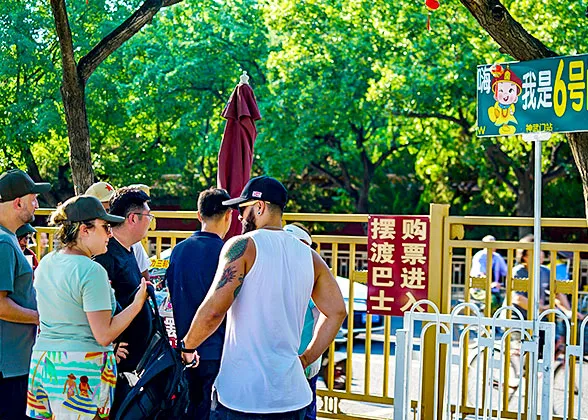 |
| Visitors Exiting from the Gate |
Upon exiting from the gate, it’s recommended to walk north for about 5 minutes to Jingshan Park. A gentle 10-minute uphill path leads to a panoramic view of the Forbidden City from the summit. Other attractions near this park include Beihai Park, Shichahai Hutong, and Nanluoguxiang Hutong.
Nearest Subway Stations & Bus Stops
The nearest subway station to the Gate of Divine Prowess is the National Art Museum Station on Line 8. After crossing the street from the Gate and turning right, it's about a 20-minute walk.
For buses, head straight across the street from the Gate and look to your right. You'll find the bus stop within a 5-minute walk. There, you can hop on lines like the Sightseeing 2, Sightseeing 3, 58, 101, or 103.
Best Photo Spots at the Gate
|
|
After exiting, cross the gate plaza and moat, then walk east or west along the moat to capture views of both the moat and the gate.
From mid-October to early November, the ginkgo trees lining the moat turn golden, during which you can use the golden leaves as a natural frame, adding vibrant colors and depth to your photos.
- Last updated on Dec. 15, 2025 by Jally Zhang -
